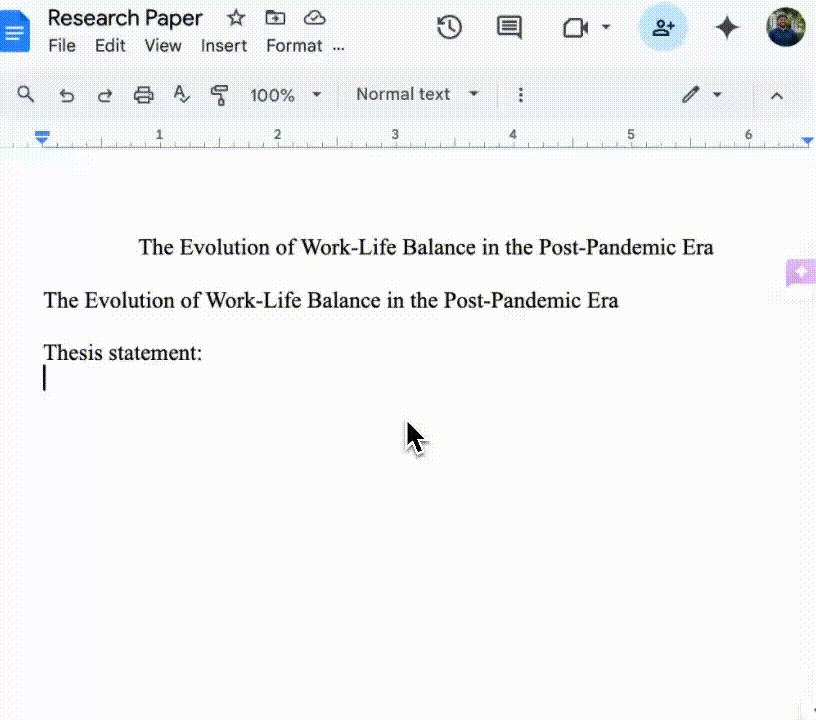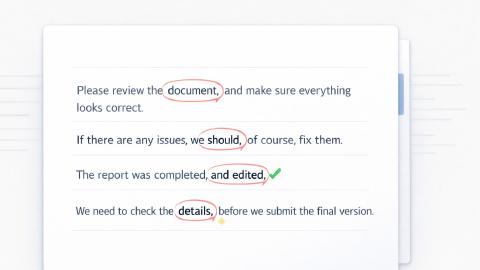Essay Writing 101: How to Write an Essay + Outline, Format & Examples
Learn how to write an essay with these tips on the outline, format, and content.
Essay writing is a fundamental skill for students of all levels. Whether it's for a class assignment, college application, or a competition, understanding the basics of essay writing can make the process smoother.
Studies show that 86% of students are already using AI in their schoolwork as of 2024.
In this article, we'll cover everything you need to know about writing an essay, provide an outline, format, and examples (and even AI tools) you can use to get started today.
What Exactly is the Writing Process for Essay Writing?
Writing an essay can feel overwhelming without a clear plan. The writing process breaks it down into manageable steps, helping you organize your thoughts and refine your work effectively.
The writing process for essay writing typically involves some order of these steps:
- Outlining
- Drafting
- Revising
- Editing
- Proofreading
Here’s a step-by-step overview:
1. Outlining
Create a clear structure for your essay, including an introduction, body paragraphs, and a conclusion. Plan your main points and supporting details before you start writing.
Check out our general outline below that you can use to get started.
2. Drafting
Write your first version, focusing on getting your ideas down without worrying about perfection. It's easier to start and edit later than try to make it perfect on the first try.
Break up the drafting process by writing different parts of the essay at a time. Ex: first do the intro, then body paragraphs, then conclusion.
3. Revising
Refine your arguments, improve clarity, and ensure your essay flows logically. This part of the process is where you go through and take a big-picture look at what you have so far.
For this step, don't look at small errors. Instead, ask yourself: does what I have so far make sense?
4. Editing
This is the step where you go through and fix grammar, punctuation, and sentence structure for polished writing. Thoroughly check your essay for any mistakes in this step.
Using online tools can make this step much easier. There are many tools that help you proofread or even rewrite parts of your essay if needed.
5. Proofreading
Do a final check for any overlooked errors or formatting issues.
Following these steps ensures your essay is well-organized, clear, and ready for submission.
Use AI Blaze to boost your essay game
General Essay Outline & Format
A well-structured essay helps communicate ideas clearly and keeps readers engaged. Academic essays typically follow a standard format that ensures logical flow and clarity.
Here is a general outline & format of an academic essay:
1. Introduction
- Start with a hook to grab the reader’s attention.
- Provide background information on the topic.
- End with a clear thesis statement outlining the main argument or purpose of the essay.
2. Body Paragraphs
- Each paragraph focuses on one main point supporting the thesis.
- Begin with a topic sentence that introduces the paragraph’s main idea.
- Include evidence, examples, or data to support your point.
- Provide analysis to explain how the evidence supports your argument.
- Use transition sentences to ensure smooth flow between paragraphs.
3. Conclusion
- Restate the thesis in different words.
- Summarize the key points discussed in the body paragraphs.
- End with a final thought or call to action to leave a lasting impression.
This structure serves as a reliable framework for organizing your ideas and presenting them in a logical order, making your essay easier to write and understand.
How to Write an Essay
Writing an essay involves crafting different sections, each serving a unique purpose in communicating your ideas. Every part, from the title to the conclusion, plays a role in building a cohesive and persuasive essay.
Here is a breakdown of each section, including its purpose, formatting guidelines, and tips for writing effectively.
Essay Heading & Title
The heading and title introduce your essay to the reader. A strong title captures attention and sets the tone for the content, while a clear heading ensures your work looks professional and meets formatting requirements.
Typically, headings follow specific guidelines based on style formats like MLA or APA. These usually include your name, course details, and date, while the title is centered and formatted in bold or italics, depending on the requirements.
When writing a title, keep it specific and relevant to your essay topic. Avoid vague or overly generic titles, and ensure your heading aligns with the required formatting style.
A well-crafted title sets expectations for the reader and establishes the focus of your essay.
Essay Introductions & Thesis Statements
The introduction serves as the opening to your essay, capturing the reader’s attention, providing context, and presenting your thesis statement. The thesis is the main argument or focus of your essay, guiding everything that follows.
Introductions are usually brief but impactful, consisting of 4–5 sentences and ending with a clear thesis statement. They should smoothly lead into the body paragraphs.
Start your introduction with an engaging hook, such as an interesting fact, a question, or a bold statement. Provide brief background information to set the context, and conclude with a thesis statement that clearly outlines the essay’s main point.
Essay Body Paragraphs
Body paragraphs form the core of your essay, where you develop your main points and support them with evidence, examples, and analysis. Each paragraph focuses on one central idea that directly connects to your thesis.
Every body paragraph should start with a topic sentence that introduces the main idea. This should be followed by supporting evidence, analysis, and a concluding sentence that wraps up the paragraph’s point. Smooth transitions between paragraphs ensure the essay flows logically.
To write effective body paragraphs, stick to one main idea per paragraph and support it with strong evidence, such as data, quotes, or real-world examples.
Make sure your analysis explains how the evidence supports your argument, and use transition words to link paragraphs together.
Essay Conclusions
The conclusion brings your essay to a close by summarizing key points and restating your thesis. It provides a sense of closure and leaves a lasting impression on the reader.
Conclusions are typically short, consisting of 3–5 sentences. They should not introduce any new information but instead reinforce what was already discussed.
When writing a conclusion, restate your thesis in different words, summarize the main points from your body paragraphs, and end with a strong closing statement. This could be a thought-provoking idea, a call to action, or a reflection on the essay’s significance.
Use AI Blaze to boost your essay game
Tips for Essay Types
Different essay types serve different purposes, and understanding their unique goals is essential for writing effectively.
Whether you're arguing a point, explaining a concept, or analyzing a subject, each type requires a specific approach.
Here are tips for writing four common essay types.
How to Write an Argumentative Essay
An argumentative essay aims to convince the reader of a particular viewpoint using evidence and reasoning. It requires presenting a clear stance and addressing counterarguments.
- Clearly state your position in the thesis statement.
- Support your arguments with credible evidence, such as statistics or expert opinions.
- Address opposing viewpoints and refute them logically.
How to Write an Informative Essay
An informative essay educates the reader about a specific topic without expressing personal opinions. It focuses on clarity, accuracy, and delivering useful information.
- Organize your essay into clear sections: introduction, body paragraphs, and conclusion.
- Use reliable sources to provide accurate facts and examples.
- Avoid personal opinions and focus on presenting objective information.
How to Write an Analytical Essay
An analytical essay breaks down a topic, text, or issue into smaller parts to examine how they contribute to the whole. It requires critical thinking and careful evaluation.
- Start with a clear thesis that outlines your analysis focus.
- Use evidence from the text or topic to support your analysis.
- Avoid summarizing; instead, focus on interpreting and evaluating key elements.
How to Write an Expository Essay
An expository essay explains a topic logically and factually. Its purpose is to provide a clear understanding of a subject without persuasion or opinion.
- Present information in a logical, step-by-step order.
- Use clear and concise language to avoid confusion.
- Include examples, facts, and statistics to support your points.
Each essay type requires a slightly different approach, but strong structure, clear arguments, and well-supported evidence are key elements in all of them.
How to Write Essays With AI

If you are looking to an AI essay writer to help you write your essays or thesis statements, give AI Blaze a try (for free)!
AI Blaze is your personal AI studying & writing assistant that helps you quickly generate thesis statements essays, and study guides!
AI Blaze can even help you take notes, answer questions, solve problems, and much more!
With AI Blaze, you can use AI to help you write essays, proofread them, and help you streamline the writing process!
Features
Generate thesis statements & essays with AI - Quickly generate thesis statements or any parts of your essay to help you streamline the writing process.
Create practice tests & check your answers - AI Blaze can even help you study by generating practice tests, grading your answers, and providing feedback!
Get help with homework - AI Blaze can answer any homework question and explain it to you to help you learn.
Instantly use GPT-4 on any site with keyboard shortcuts and a dynamic AI sidebar assistant!
AI Blaze is free! - Forget about annoying licenses or subscriptions
Automate any task with AI, like rewriting text, generating new text, summarizing text, paraphrasing text, and much more!
Use AI Blaze to boost your essay game
Essay Writing FAQ
Students often face common challenges when writing essays, from crafting a strong hook to correctly formatting titles.
This section answers frequently asked questions to help you navigate these tricky areas with confidence.
How Do I Write a Hook for an Essay?
A hook is the opening sentence of your introduction, designed to grab the reader's attention. It sets the stage for your essay and encourages readers to keep going.
Effective hooks can be a surprising fact, a thought-provoking question, a bold statement, or a brief anecdote.
Example: "Did you know that 70% of people check their phones within five minutes of waking up?"
A strong hook should connect to your essay topic and smoothly transition into the background information and thesis statement.
How Do I Write a Book Title in an Essay?
Book titles in essays are typically italicized to distinguish them from the rest of the text.
For example, you would write: To Kill a Mockingbird by Harper Lee.
If you're handwriting your essay or unable to use italics, underline the book title instead. Shorter works, like short stories or chapters, should be placed in quotation marks.
Always follow the formatting style specified by your instructor, such as MLA, APA, or Chicago style.
How Do I Write a Movie Title in an Essay?
When referencing a movie in an essay, the title should be italicized, like The Godfather. This formatting helps the reader easily identify it as a title.
If italics are not possible, underline the movie title instead. Avoid using quotation marks for full-length films, as these are reserved for shorter works like episodes or short films.
Always check your style guide for specific requirements.
Use AI Blaze to boost your essay game
How Do I Write a Thesis Statement?
A thesis statement is a single sentence that clearly expresses the main argument or purpose of your essay. It typically appears at the end of your introduction and serves as a roadmap for your essay.
A strong thesis is specific, arguable, and concise. Everything in your essay should connect back to this statement, reinforcing your main point.
For example: "Social media has both revolutionized communication and contributed to increased anxiety among teenagers."
Understanding these common questions will help you avoid errors and write essays that are clear, polished, and professional.
Boost Essay Writing With AI Blaze
Mastering essay writing starts with understanding the purpose and structure of each section, from crafting a strong introduction to wrapping up with a clear conclusion.
With practice and attention to detail, anyone can improve their essay-writing skills. Follow the tips in this guide, and you'll be well-equipped to tackle any essay assignment confidently.
Use AI Blaze to write essays, generate thesis statements & study guides, and boost your study game using AI for free!




